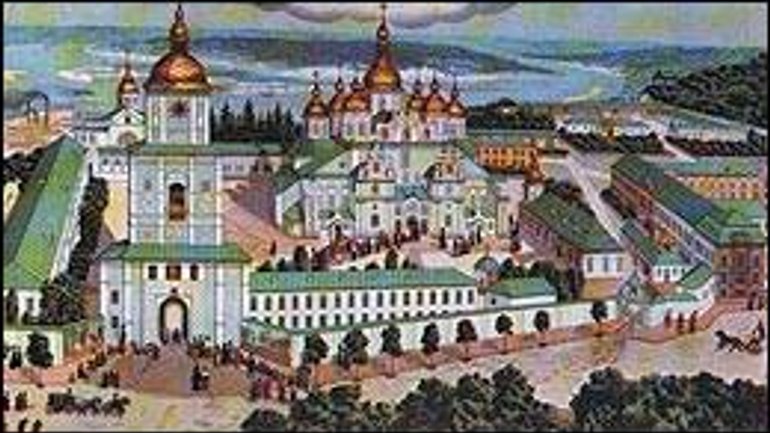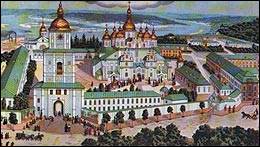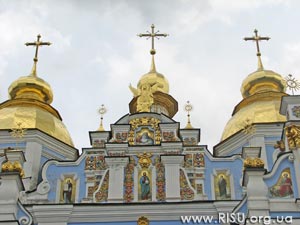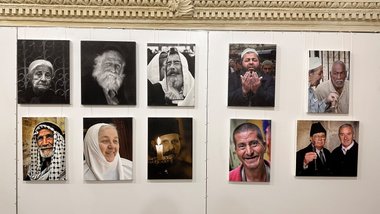St. Michael’s Golden-Domed Church in Kyiv Marks 900 Years

 The history of any people, unfortunately, is composed not only of its glorious pages. There are also bitter things about which it is subsequently very shameful to recall. From the 1930s to the 1950s we lived through the Stalinist period of the self-destruction of our own culture and spirituality, the widespread ruin of national shrines. These ancient temples and thousands of churches managed to survive for many ages, through numerous attacks of soldiers, being a center of the national spirit which, perhaps, allowed the Ukrainian people to withstand all the sufferings and trials of the bad times. However, many were not fated to survive the most terrible destruction, that of the Bolsheviks.
The history of any people, unfortunately, is composed not only of its glorious pages. There are also bitter things about which it is subsequently very shameful to recall. From the 1930s to the 1950s we lived through the Stalinist period of the self-destruction of our own culture and spirituality, the widespread ruin of national shrines. These ancient temples and thousands of churches managed to survive for many ages, through numerous attacks of soldiers, being a center of the national spirit which, perhaps, allowed the Ukrainian people to withstand all the sufferings and trials of the bad times. However, many were not fated to survive the most terrible destruction, that of the Bolsheviks.
Of course, it is easier to look outside for those guilty in disagreements than to repent and admit one’s sins. For, sad though it is, the main executors of foolish party decisions were our fellow countrymen. But history has taught us nothing. Today, as in the years of independence, problems with the renewal and maintenance of Ukraine’s shrine are still far from resolved, and here we have something to think about.
However, the history of the ruin and revival of St. Michael’s Gold-Domed Monastery and Church in Kyiv, an ancient Orthodox shrine of the Ukrainian people, is a shining witness that the world is developing in a positive direction. The spirituality of Ukraine is being reborn.
 Oleksandr Kozlovskyi, a correspondent of UKRINFOM, learned about the particular history, tragic destruction, and glorious resurrection of this majestic shrine from Bishop EVSTRATII (ZORIA), head of the Information-Publishing Department of the Ukrainian Orthodox Church-Kyivan Patriarchate (UOC-KP).
Oleksandr Kozlovskyi, a correspondent of UKRINFOM, learned about the particular history, tragic destruction, and glorious resurrection of this majestic shrine from Bishop EVSTRATII (ZORIA), head of the Information-Publishing Department of the Ukrainian Orthodox Church-Kyivan Patriarchate (UOC-KP).
Orthodox shrines like St. Sophia’s and the Kyivan Monastery of the Caves are well-known to any average citizen, even with a school textbook… But for a long time there was almost no information about St. Michael’s Gold-Domed Monastery. Perhaps memories of the ruin of this unique church in the times of the former regime called forth uncomfortable questions?
To admit one’s mistakes, courage is necessary, because an unrepeatable historical structure was ruined, one of the oldest shrines of Ukraine. St. Michael’s Church was built at the monastery in honor of the martyr St. Demetrius of Thessalonica and founded by the son of Yaroslav the Wise, Grand Prince of Kyiv Iziaslav Yaroslavovyvch, near his royal court in the middle of the 11th century. In 1108, according to the chronicle, “on the 11th day of July,” the grandson of Yaroslav the Wise, Prince Sviatopolk Mykhail (Michael), laid the foundation for the Church of St. Michael of the Golden Domes.
Why is the church called “Golden-Domed,” for today there are many majestic cathedrals and small churches with gilded domes? The fact is that at that time it was the first church with gilded domes. Even St. Sophia’s Cathedral and the Tithe Church at that time still did not have this. This was so fascinating for the people of Kyiv at that time that they named the church “St. Michael’s Golden-Domed.” That was the start of the tradition.
And this was the last church adorned with mosaics. After this, in the Kyivan state they did not adorn churches with mosaics, for this was a very complicated and expensive type of work. In comparison with the mosaics of St. Sophia’s, which are essentially Byzantine and follow Byzantine models, the creations of St. Michael’s Church are unique, for in them are joined together elements of local monumental art. They were more alive. In the mosaics of St. Michael’s, for example, each apostle is depicted as an individual and distinguished from the others, even by the body position and facial expression, which distinguishes them from the Byzantine tradition, where only an expert can notice differences.
And though the church was ruined, 45 square meters of mosaics and a few dozen square meters of frescoes are still preserved. A significant part of these today are found in St. Sophia’s Cathedral. In particular, a part of the mosaic of St. Demetrius of Thessalonica and the fresco of St. Nicholas were taken to Russia for an exhibition of old Rus art back in 1938, but they were never brought back from there. Another part during the occupation ended up in Germany, and then, after the war, were returned, but not to Kyiv but to Russian museums. The spiritual and artistic treasures of St. Michael’s Church today are kept also in the Hermitage and the Tretyakov Gallery [in Russia].
The History of St. Michael’s Monastery and Church are in a special way connected with the name of St. Barbara the Great Martyr. The wife of Prince Sviatopolk, who in baptism received the name Mykhail (Michael) (in honor of his holy patron he built the church), was a Greek princess. Traveling to Kyiv from Constantinople, she brought with her great holy items, including relics of St. Barbara which were preserved in the new-built church for more than eight centuries.
In 1240 the monastery was destroyed by the Mongol-Tatars, but the church was preserved. And at the end of the 13th and start of the 14th centuries religious services and monastic life were revived here. The monastery became one of the leading shrines of Kyiv; the glory which it had in the pre-Mongol period returned to it. St. Michael’s Monastery became the second pilgrimage site in Kyiv after the Kyivan Monastery of the Caves. One can make a judgment about the great number of pilgrims at least from the fact that, during the second half of the 19th century, the monastery built three structures to receive visitors, hotels where a few thousand people could stay at one time.
The monastery experienced particular development from the start of the 17th to the first half of the 18th centuries. It became the center of the renewed Kyivan Metropolitanate. After this, when as a consequence of the Union of Brest [with Rome in 1596] the Polish governmental authorities refused to acknowledge the Orthodox Kyivan Metropolitanate, it remained for some time without a metropolitan or hierarchy.
In 1620 Patriarch Theophanes of Jerusalem under the protection of Cossack Petro Konashevych-Sahaidachnyi and at the request of the hetman ordained a metropolitan and bishops for the Orthodox Kyivan Metropolitanate. The ihumen (abbot) of St. Michael’s Golden-Domed Monastery, Iov (Boretskyi), a gifted personality of Ukrainian history, was elected metropolitan. He had a wonderful European education, was one of the founders of the first public, open brotherhood school in Lviv and was honored for the rebirth and simply the establishment of education and also for the renewal of the Orthodox Kyivan Metropolitanate. During his term as metropolitan, St. Michael’s Monastery became [the metropolitanate’s] center.
Iov’s great successor was another noted Kyivan saint, Petro Mohyla, who combined the position of metropolitan with being superior of the Kyivan Monastery of the Caves and also of St. Michael’s Golden-Domed Monastery.
In the first half of the 18th century the architectural flourishing of the monastery occurred. Two additions in honor of St. Barbara the Great Martyr and St. Catherine the Great Martyr were built on to the central ancient Rus part of the church. The bell-tower of the monastery was built. The church acquired Baroque forms. To the single central dome another six were added.
Hetman Ivan Skoropadskyi at his own cost donated a wonderful, majestic icon-screen to the church. By the way, today you can see a copy of its lower row, which in the 18th century had many rows and fully covered the whole horizon of the altar. But in 1888, when during restoration work old Kyivan mosaics were found under a layer of later oil paintings on the altar, they decided to reveal them. With such an appearance the church encountered the stormy 20th century.
Why did they decide to ruin this unrepeatable church with such a rich, unique history, a true pearl of ancient Slavic history?
The Christian faith, the value of each human soul without exception, was not registered in the plans of the totalitarian regime of the time, where the human person was given the role of a small screw in the government mechanism. During the times of the Soviet regime the monastery was closed, the monks evicted. It was transformed into a little students’ town. Various Soviet organizations settled in the former monastic cells. However, still for some time they were allowed to celebrate religious services in the church, but in 1929 they closed it, transforming it into an archival depository.
But in 1934, when the capital of Soviet Ukraine was moved from Kharkiv to Kyiv, the question was raised about rebuilding the government center. They decided to built it on the very site of St. Michael’s Church. A state commission under the direction of People’s Commissar of Education Balytskyi was created and issued a terrible decree that St. Michael’s Church “has neither historical, nor cultural, nor architectural value, and so can be taken down.” One of the participants of the commission, scholar Mykola Omelianovych Makarenko, did not sign this criminal act, for which he paid with his life: in the years of repressions he was shot. In memory of this civic heroism, on the walls by the entrance to the monastery near the Steward’s [Ekonom’s] Gates, they placed his bust. Fedir Ernst and Ipolyt Morhilevskyi also stood for the preservation of St. Michael’s Golden-Domed. Later they also were “liquidated,” like the church itself. The only thing that the scholars managed to do was to preserve the most valuable mosaics and frescoes. They had only nine months to do this difficult work, which for such a matter is very little time.
In 1935 they started to demolish the church, and on 14 August 1937 it was leveled. Though the church was gone, they did not build anything else on its site. Perhaps the war interfered. Imagine how easy this complex would have been: If you stand on St. Michael’s Square and look left from the building of today’s Ministry of Foreign Affairs. Just the same kind of structure, a quarter circle with a great colonnade in Stalin-imperial style, was to give symmetry on the site of St. Michael’s Church. In the center of them a 34 meter memorial to the chief of the proletariat. Parade steps were to lead down to the Dnipro, and they planned to take down all the buildings from St. Sophia’s Cathedral to this complex, creating a great parade square.
An even more terrible project existed: constructing a six-lane paved highway from the railroad station to the government center. In this way, the cathedrals of St. Sophia and St. Volodymyr would also have been taken down. The goal of the architectural “idea” was that a person who traveled to Kyiv right from the doors of the train station would see all the grandeur of the Soviet regime. Thank God that this project of gigantic-mania was not brought to life.
Already in the post-war time a new idea came into a few heads: on the occasion of the 100th anniversary of the birth of Vladimir Lenin to build a museum to him on the foundations of St. Michael’s Church. But that was already not Stalinist times, and scholars and artists were now able to defend the site from rebuilding.
The resurrection of St. Michael’s Church was a true miracle of the Lord. But God performs miracles often through the hands of his faithful people. How did the rebirth of the church happen?
Gradually the times began to change. At the start of the 1990s they returned to the church the single surviving worship structure, dedicated to John the Theologian, Apostle and Evangelist, a small refectory church near St. Michael’s Church. And in 1992 archeological work started on the foundations of St. Michael’s Monastery. There were many interesting archeological discoveries and much was established about the architecture of the church itself. Some of the items discovered are today on exhibit at the museum of the history of the revival of St. Michael’s Monastery, which is located on the premises of the bell-tower.
Two noted figures were involved in the renewal of St. Michael’s Monastery, two Ukrainians, each of whom is a symbol in a separate sphere of spiritual life. These are Patriarch Mstyslav (Skrybnyk) of blessed memory [first patriarch of Kyiv and all Ukraine of the Ukrainian Autocephalous Orthodox Church- editor’s note] the first patriarch of the Ukrainian church, and Oles Terentiiovych Honchar, a noted author who is acclaimed for his work “Sobor” (Cathedral). At the start of the 1990s, Oles Honchar started first discussing the need to renew St. Michael’s Golden-Domed and established a special fund. And, though Oles Terentiiovych himself, unfortunately, did not live to see the time when the church was renewed, it is necessary to link his name with the very idea of rebuilding the church.
In 1997 the government became involved with the renewal of the church. Then President of Ukraine Leonid Danylovych Kuchma signed an order to renew the main historical shrines, in particular St. Michael’s Church and the Dormition Church of the Kyivan Monastery of the Caves. However, the main work lay on the shoulders of Oleksandr Oleksandrovych Omelchenko, then mayor of Kyiv, and, particularly, his first assistant, Stanislav Telisforovych Stashevskyi, who knew about building questions. They did extremely much so that these churches came up from the ruins.
In 1998 the bell-tower of St. Michael’s Monastery was renewed, and in 2000 the church itself was renewed. Since then, every day religious services are held there. This is a monastery church; the Orthodox Theological Academy is on its territory, an educational institution in which they prepare future priests. Every day thousands of people visit this place. And no person remains indifferent. By the way, there were many discussions of whether it is necessary or unnecessary in difficult economic conditions to revive this church. But when St. Michael’s Golden-Domed rose in all its beauty, all these discussions stopped.
Because of the many visitors to the church, you can feel a positive energy on the whole territory of the monastery…
St. Michael’s Golden-Domed is not simply a rebuilt structure, but an exceptionally active spiritual shrine. And, as a religious minister who served at St. Michael’s Monastery, I can attest that many people, even nonbelievers, came up to me to say: “Here I am, not a religious person. I don’t go to church, but, walking near this church I felt a strong desire to come in and pray.” In this church people feel peace and the renewal of spiritual strength. And this is not strange, because this church, resurrected from the ruins, even by itself influences people, for it is truly filled with the Spirit of God.
And this is an answer to the question why, in general, churches are necessary. For sometimes among people of other denominations or those baptized in the Orthodox church but unchurched the question arises: “But why go to church? God is in my soul. Holy scripture attests that each person is a temple of the Holy Spirit.”
This is all true, but these churches made by human hands, majestic and wonderful, are also necessary. They are, first of all, our display of love for God. This is similar to how we show our love for relatives and neighbors with some material things. Finally, when a young man gives a young woman some beautiful things, he does this not because she would not be pretty or dear without them, but because this is a manifestation of his love and respect. In the same way we, being miraculous temples, express our spiritual love through material things. For God did for us significantly more. And even this revival of St. Michael’s Monastery is a miracle of God, for when the church was destroyed, no one even believed that it would rise from the ruins. This witnesses that the Lord can even revive his shrine from ashes.
I expect that the marking of this jubilee of St. Michael’s Golden-Domed Monastery will give an impetus not only to the further rebirth of spirituality in Ukraine but also to the development of Orthodox monasticism, for no church will have appropriate spiritual development if it will not have its spiritual “heroes.” And this celebratory event on the highest state level in honor of the jubilee will not only be appropriate respect for the great and glorious history of the monastery, but a witnessing to the unconquered spiritual strength of the Ukrainian people.










